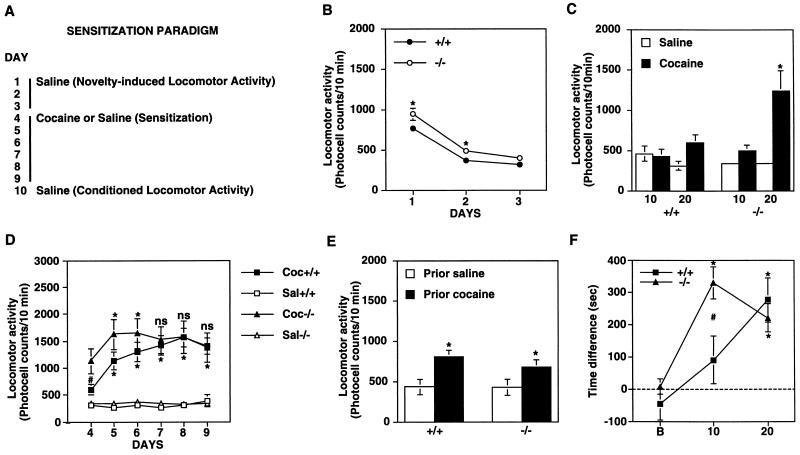Figure 2.
Regulation of the locomotor and rewarding effects of cocaine in wild-type and fosB mutant mice by cocaine. (A) The experimental protocol used to assess spontaneous locomotor activity, locomotor activity induced acutely by cocaine, locomotor sensitization to repeated cocaine administration, and conditioned locomotor activity. (B) Locomotor activity counts of wild-type littermates (+/+) and fosB mutant mice (−/−) on 3 consecutive days of saline treatment. ∗, statistically significant differences between wild-type and mutant mice (P < 0.05). (C) Locomotor activity induced by a single, acute cocaine injection (10 or 20 mg/kg i.p.). ∗, statistically significant differences between saline- and cocaine-treated groups (P < 0.05). (D) Locomotor sensitization to repeated cocaine injections (20 mg/kg i.p.) in wild-type and mutant mice. The upper and lower symbols [∗, (P < 0.05) and ns (not statistically different)] indicate differences from day 4 in the mutant and wild-type mice, respectively. #, statistically significant difference between the mutant and wild-type mice. (E) Conditioned locomotor activity in wild-type (+/+) and mutant (−/−) mice. On day 10, mice that previously had received saline or cocaine were given an additional saline injection and locomotor activity was measured. ∗, statistically significant differences between prior-cocaine and prior-saline groups (P < 0.05). (F) CPP established by cocaine (10 or 20 mg/kg, i.p.). Time difference, obtained by subtracting time animals spent in the saline-paired side from time they spent in the cocaine-paired side. B, preconditioning baseline. ∗, statistically significant preference. #, statistically significant difference between +/+ and −/− mice.

